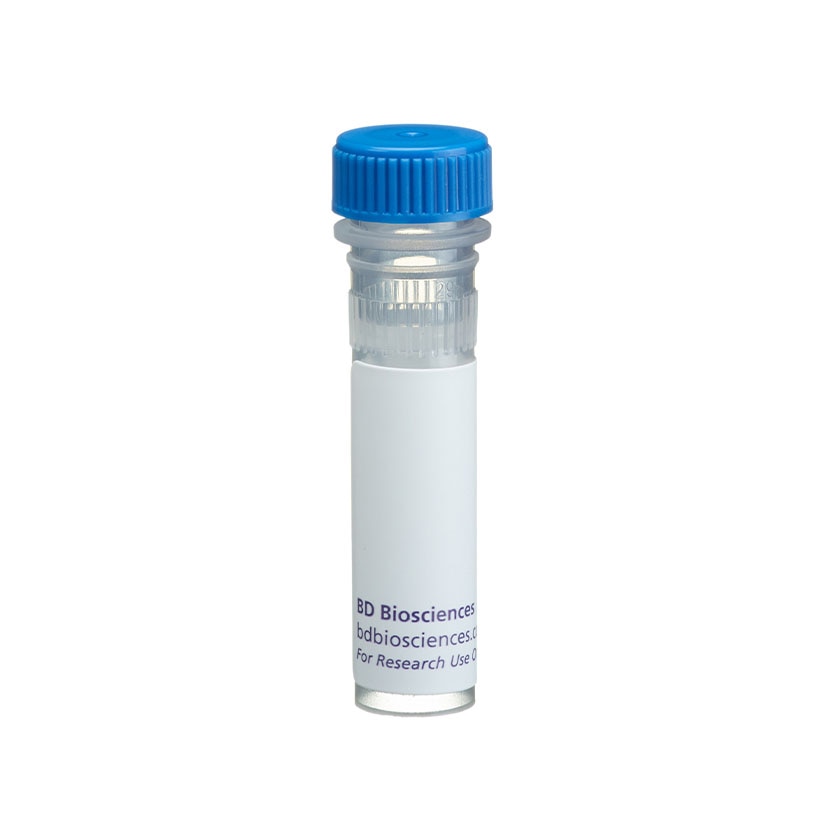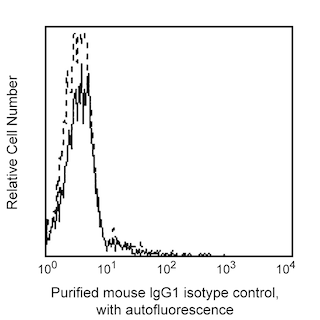Old Browser
This page has been recently translated and is available in French now.
Looks like you're visiting us from {countryName}.
Would you like to stay on the current country site or be switched to your country?




Flow cytometric analysis of CD9 expression on human peripheral blood platelets. Platelets stained with either Purified Mouse Anti-Human CD9 (Cat. No. 555370; solid line histogram) or Purified Mouse IgG1, κ Isotype Control (Cat. No. 555370; dashed line histogram), followed by FITC Goat Anti-Mouse IgG/IgM (Cat. No. 555988). Fluorescent histograms were derived from gated events with the forward and light-scattering characteristics of viable platelets.


BD Pharmingen™ Purified Mouse Anti-Human CD9

Regulatory Status Legend
Any use of products other than the permitted use without the express written authorization of Becton, Dickinson and Company is strictly prohibited.
Preparation And Storage
Recommended Assay Procedures
This reagent is effective for indirect immunofluorescence staining of human cells for flow cytometric analysis, western blotting with human platelets lysate at 2-4 µg/ml (in-house data), and immunohistochemistry on frozen tissue (spleen/thymus) sections at 2-10 µg/ml (in-house data). However, we do not recommend using this antibody on the formalin fixed paraffin tissue sections.
Product Notices
- Since applications vary, each investigator should titrate the reagent to obtain optimal results.
- An isotype control should be used at the same concentration as the antibody of interest.
- Caution: Sodium azide yields highly toxic hydrazoic acid under acidic conditions. Dilute azide compounds in running water before discarding to avoid accumulation of potentially explosive deposits in plumbing.
- Sodium azide is a reversible inhibitor of oxidative metabolism; therefore, antibody preparations containing this preservative agent must not be used in cell cultures nor injected into animals. Sodium azide may be removed by washing stained cells or plate-bound antibody or dialyzing soluble antibody in sodium azide-free buffer. Since endotoxin may also affect the results of functional studies, we recommend the NA/LE (No Azide/Low Endotoxin) antibody format, if available, for in vitro and in vivo use.
- Please refer to www.bdbiosciences.com/us/s/resources for technical protocols.
Companion Products

.png?imwidth=320)
The M-L13 monoclonal antibody specifically binds to a 24 kDa type III transmembrane protein that is expressed on platelets, pre-B cells, monocytes, endothelial and epithelial cells. CD9 belongs to a family of membrane proteins called tetraspanins that transverse the membrane four times. CD9 is weakly expressed on resting mature B cells. M-L13 induces platelet aggregation and activation. This antibody is also suitable for staining acetone-fixed, frozen tissue sections.
Development References (5)
-
Barclay NA, Brown MH, Birkeland ML, et al, ed. The Leukocyte Antigen FactsBook. San Diego, CA: Academic Press; 1997.
-
Cramer EM, Berger G, Berndt MC. Platelet alpha-granule and plasma membrane share two new components: CD9 and PECAM-1. Blood. 1994; 84(6):1722-1730. (Biology). View Reference
-
Knapp W. W. Knapp .. et al., ed. Leucocyte typing IV : white cell differentiation antigens. Oxford New York: Oxford University Press; 1989:1-1182.
-
Masellis-Smith A, Shaw AR. CD9-regulated adhesion. Anti-CD9 monoclonal antibody induce pre-B cell adhesion to bone marrow fibroblasts through de novo recognition of fibronectin. J Immunol. 1994; 152(6):2768-2777. (Biology). View Reference
-
McMichael AJ. A.J. McMichael .. et al., ed. Leucocyte typing III : white cell differentiation antigens. Oxford New York: Oxford University Press; 1987:1-1050.
Please refer to Support Documents for Quality Certificates
Global - Refer to manufacturer's instructions for use and related User Manuals and Technical data sheets before using this products as described
Comparisons, where applicable, are made against older BD Technology, manual methods or are general performance claims. Comparisons are not made against non-BD technologies, unless otherwise noted.
For Research Use Only. Not for use in diagnostic or therapeutic procedures.
Report a Site Issue
This form is intended to help us improve our website experience. For other support, please visit our Contact Us page.